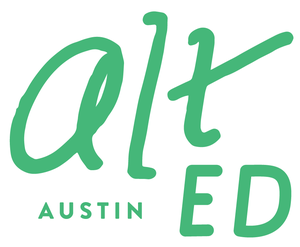Why storytelling is better than lecturing
/Guest contributor David Sewell McCann is chief tale spinner for sparklestories.com, a streaming website of original children’s audio stories. He has honed his four-step process of intuitive storytelling from years as an elementary school teacher and parent and now teaches workshops around the country. He and his family live in Austin, where their children attend alternative schools. We are thrilled to bring you some of David’s wisdom, along with a very special Sparkle Stories offer just for Alt Ed Austin readers!
My son left the gate open again, and the dog is in the street.
My daughter is worried about catching the Zika virus.
He is afraid of grasshoppers, while she is sure she doesn’t have to brush her teeth.
Every day we parents hear about our children’s fears, aspirations, assumptions, confusions, and concerns, and we, as the primary adults in their lives, want to help. We want to tell him it’s OK. We want to explain to her why it is important to recycle. We want him to know that it is extremely unlikely that he will encounter a member of ISIS. We want to list out all the reasons why it is not OK to pinch her sister.
We want them to understand—and then we want them to feel better or change their behavior. And yet, most of the time, nothing really changes.
She is still worried. He left the gate open. Why don’t they listen?
Well, I believe it is because you are not speaking their language. You are explaining, when you might want to try describing.
Explaining is the language of science, statistics, and law. It is factual— fixed—and basically a dead language. It works for specificity and clarity but doesn’t work as well for change.
Describing is organic. It develops, it changes, it is dynamic, and it is what happens when we tell a story. Storytelling is the language of children.
If you don’t believe me, next time you want to get your child’s attention, try saying the four words “Once upon a time,” and see what happens. Those four words are the most potent spell any wizard can utter. It means that something very magical is about to unfold—something transformative, something unexpected: a story is about to be told. The room quiets, eyes glaze over, jaws slacken, and your child becomes a vessel ready to hear your wisdom.
And then comes your chance to deliver the wisdom of your choice. Tell a story about a boy who left the gate open one too many times and his favorite chicken ran away to live at the neighbor’s farm. Spin a yarn about the most charming, lovable grasshopper that ever was. Unfold a tale about a girl who was so surrounded in love that no illness could touch her.
And here is the thing: the story doesn’t have to be any good. Really. It can be the worst story ever told, and yet your child will manage to extract the magic, will find the wisdom, will sift through all the rubble and find the gold.
And they will thank you for it.
For inspiration, or if you find the craft of storytelling too daunting, then try out sparklestories.com and listen to some of our stories. You can input search words like “chores” or “fear of bugs” or “valentines” or “sensory integration” and several audio story options will appear before your eyes. There are now almost 900 original stories in the catalog, so there will surely be something there for you and your child.
If you input the code ALTED (all one word, all caps) then you can extend your free trial period to 15 days at no charge. And you will love the app that comes with a subscription!
For more information on storytelling, child development, and child study, you can click on the “Sparkle Schoolhouse” category on our blog here.
Meanwhile, when you are faced with a behavior or emotion or dynamic with your child that you would like to change, try this:
Close your eyes and take a breath. Do whatever you can to inch toward a grounded, peaceful place (even if it is only an inch) and then, ask your child, “What is one of your favorite animals in all the world?”
He or she will stop and think about it. Give a reminder that it’s “in all the world”—in Africa, Australia, in South America, in the jungle, the savannah, the arctic—anywhere.
When an animal is declared, say, “I’m going to tell you a story about that animal.”
Then tell one. Go ahead and tell a clunky, awkward, poorly formed story starting with “Once upon a time” all the way to “The End,” and . . . see what happens. As best you can, try not to judge yourself. You are just starting. Listen to some of our stories, or those of other storytellers, for inspiration. And then . . . try again. It will be well worth it.
David Sewell McCann























